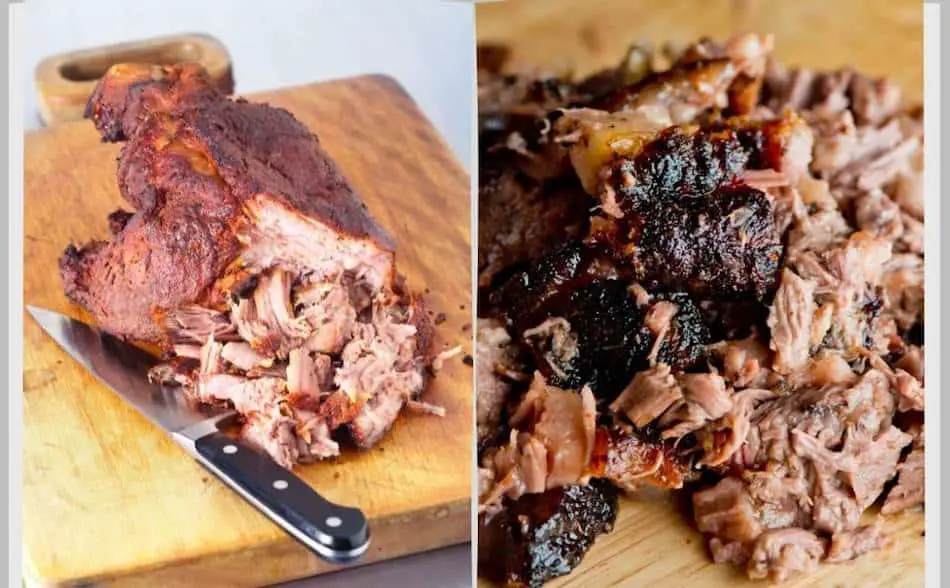
Two of the most popular smoking meats would have to be brisket and pulled pork, also known as pork butt. Both of these meats are considered “big meats” as they require a significant amount of time and attention to cook. Despite the lengthy cooking time, the end result is well worth it as these meats are packed with flavor and are sure to be a hit with any crowd. In this article, we will take a closer look at these two meats, comparing their similarities and differences, and discussing the best ways to prepare and cook them.
Brisket and pulled pork are two popular smoking meats, each with their own unique flavors and cooking methods. Brisket is a larger, more expensive cut of beef from the chest area of the cow, which requires a long cook time of 8-15 hours and can be challenging to cook.
Pulled pork, also known as pork shoulder or pork butt, is a more affordable and versatile cut of pork from the shoulder area of the pig, which is easier to cook and takes 6-8 hours. Both meats require low-and-slow cooking at a temperature range of 225-250°F. Brisket is considered a delicacy, while pulled pork is more commonplace. Both meats can be served as pulled meat and contain a lot of connective tissue. Pork shoulder is more forgiving to cook than brisket and can be cooked at higher temperatures.
What’s better? Brisket or Pork?
Pork butt and brisket are two very different cuts of meat that offer distinct flavors and textures. Pork butt, also known as pork shoulder, is a cut of meat that comes from the shoulder of the pig. It’s a flavorful cut of meat that has a rich, porky flavor and a tender texture when cooked properly. It’s a staple of barbecue cuisine and is often used in sandwiches, tacos, and other dishes. It’s relatively affordable, and it’s a more common cut of meat that can be found in most grocery stores.
Brisket, on the other hand, is a large cut of beef that comes from the chest or pectoral muscle of the cow. This muscle is a hardworking muscle that supports the animal’s weight and movement, which is why it contains a lot of connective tissue. This connective tissue, when cooked properly, melts down and gives brisket its rich, beefy flavor and tender texture. A perfectly smoked brisket is considered by many as a delicacy, as the rich flavor and tender texture are unbeatable. Brisket is often used in barbecue and Tex-Mex cuisine and is considered as a more premium cut of meat.
Both pork butt and brisket are delicious in their own way and can be equally good if cooked and prepared well. However, the taste and texture of both cuts of meat are very different and some people may prefer one over the other. A smoked brisket is almost seen as a delicacy in some parts, whereas pulled pork is more commonplace. Many people consider a perfectly smoked brisket as unbeatable, due to the rich flavor and tenderness that comes from the connective tissue melting down during the cooking process.
Beef vs Pork
Brisket and pork butt are two very different cuts of meat that come from two different animals, beef and pig respectively. They have distinct flavors and textures that set them apart, but they do have some similarities. Both cuts come from the forequarter of the animal, which means they come from similar muscle groups that are used frequently and are rich in connective tissue.
Brisket is a large cut of beef that comes from the chest or pectoral muscle of the cow. This muscle is a hardworking muscle that supports the animal’s weight and movement, which is why it contains a lot of connective tissue. This connective tissue, when cooked properly, melts down and gives brisket its rich, beefy flavor and tender texture. Brisket is considered a delicacy and is often used in barbecue and Tex-Mex cuisine.
On the other hand, pulled pork, also known as pork butt or pork shoulder, is a cut of meat that comes from the shoulder of the pig. This muscle is also a hardworking muscle that supports the animal’s weight and movement, which is why it contains a lot of sinews and connective tissue. This connective tissue, when cooked properly, melts down and gives pulled pork its rich, porky flavor and tender texture. Pulled pork is a staple of barbecue cuisine and is often used in sandwiches, tacos, and other dishes.
Similarities And Differences
There are many similarities between the two roasting meats.
Similarities
- Brisket and pulled pork need to be cooked low-and-slow.
- Both cuts are long cooks (over 8 hours).
- The best temperatures for cooking pulled pork and brisket is between 225° F and 250° F.
- Brisket and pulled pork contain a lot of connective tissue.
- Both cuts are from the forequarter of the animal.
- Both pork shoulder and brisket can be served as pulled meat.
Differences
- They are different animals. Brisket is beef and pulled pork is from a pig.
- Pulled pork takes 6 to 8 hours to cook. Brisket takes 8 to 15 hours to cook.
- Brisket is a much larger roast.
- Pulled pork is more affordable.
What is Brisket?
The smoked brisket is the king of barbecue meat. If you learn how to master a brisket, everyone will be inviting you to their barbecues. Brisket is a large cut of beef taken from the pectoral muscle (or the chest area of the cow). This part of the animal is a hard working muscle, which is why brisket contains a lot of connective tissue. If not cooked correctly, a brisket would be inedible. However, when cooked low-and-slow, the fat and connective tissue in brisket is transformed into the some of the most delicious tasting meat on the planet. The connective tissue the the size of brisket is one of the reasons it can take up to 15 hours to cook.
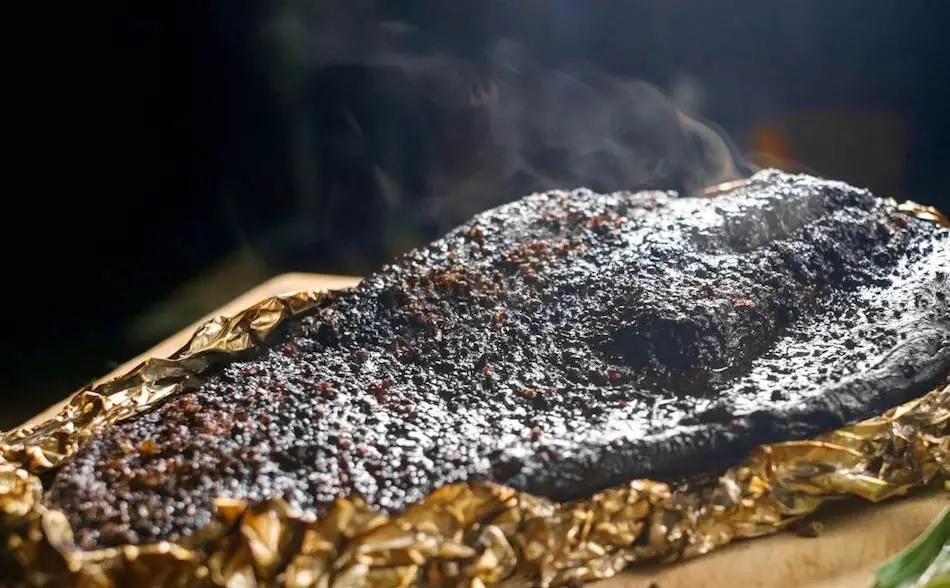
| Meat | Pros | Cons |
|---|---|---|
| Pork Butt | More affordable | Can dry out if cooked at too high a temperature |
| Pork Butt | Easier to cook | Less flavorful than brisket |
| Pork Butt | Versatile | Can be less tender than brisket if not cooked properly |
| Brisket | Amazing flavor | More expensive |
| Brisket | Perfectly smoked brisket is unbeatable | Can be challenging to cook |
| Brisket | Longer cook time results in more tender meat | Takes longer to cook than pulled pork |
What is Pulled Pork?
Pork shoulder, pork butt, Boston butt, are all the same names for the same cut of pork. This is the part of the pork that is used to make pulled pork. Pork shoulder is one of the best meats to smoke If you’re new to low-and-slow cooking.
I would recommend smoking a dirk shoulder before attempting a brisket. Before smoking a brisket, it’s good to master the fundamentals before tackling a brisket. Smoking a brisket isn’t easy. Pork butt, on the other hand, is better suited for beginners. They say pork butts are hard to mess up, whereas a brisket—lots can go wrong.
Aaron Franklin Pork Butt (Pulled Pork) Recipe And Technique
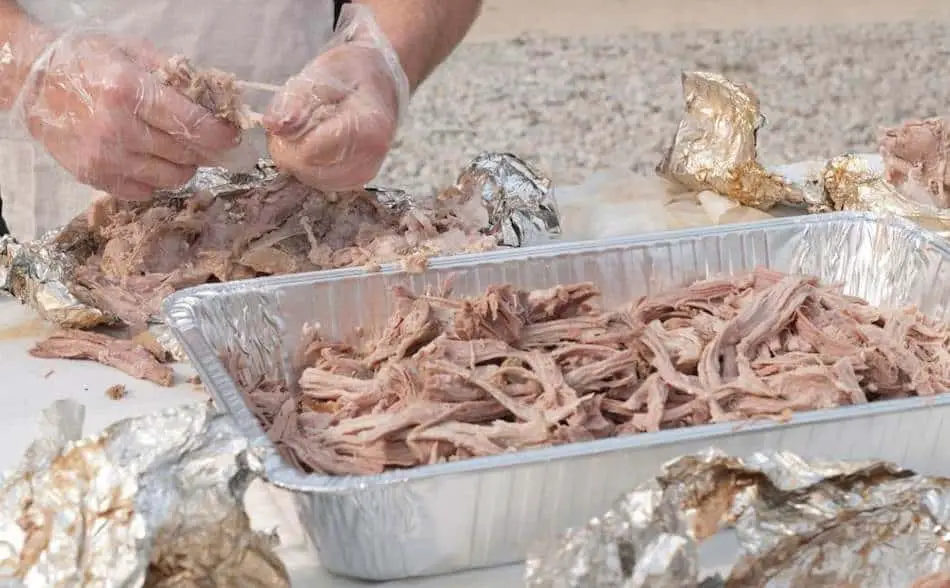
Cooking Time Difference
A pork shoulder will take about 8 to 10 hours when cooking low-and-slow. A brisket may take upwards of 15 hours depending on the size. Both cuts of meat contain a lot of sinew, which need time to break down. However, brisket usually needs longer.
| Meat | Weight | Cooking Temp | Cooking Time |
|---|---|---|---|
| Pork Butt | 5-7lbs | 225-250°F | 6-8 hours |
| Pork Butt | 8-10lbs | 225-250°F | 8-10 hours |
| Pork Butt | 10-12lbs | 225-250°F | 10-12 hours |
| Brisket | 5-7lbs | 225-250°F | 8-10 hours |
| Brisket | 8-10lbs | 225-250°F | 10-12 hours |
| Brisket | 10-12lbs | 225-250°F | 12-15 hours |
Pulled Pork is More Forgiving
When comparing brisket and pulled pork, brisket is definitely more challenging to cook. The difficult thing with brisket is it contains two muscles, a point and a flat. The point is easier to cook, but the flat can cause a lot of problems. This part or muscle of the brisket is lean and thin. Often the flat will take longer to cook, and will be 5°F behind the point for most of the cook. Pork shoulders are more forgiving. Even if the temperature of your smoker spikes, you won’t ruin your pork shoulder.
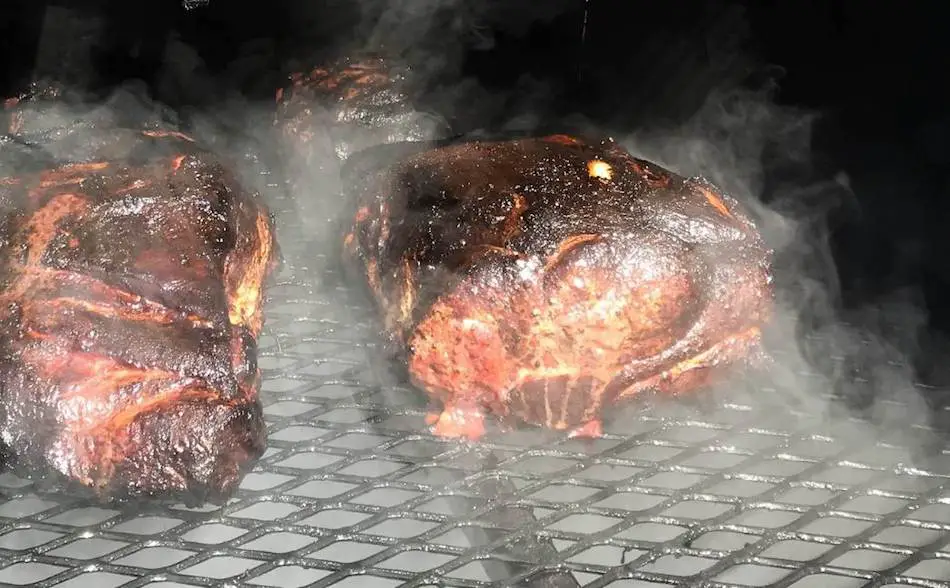
Cook Pork at Higher Temperature
I wouldn’t recommend smoking a brisket any higher than 250° F, but a pork shoulder can be cooked comfortably at 275° F. Barbecue pitmaster Aaron Franklin will cook his briskets at 250°F, and he will do his pork shoulders, ribs, etc at 275° F.
Taste Difference
Brisket and pulled pork are both popular choices for barbecue, but they are quite different in terms of taste and preparation. Brisket is considered a delicacy and is often seen as a prized, sought-after barbecue meat, while pulled pork is more cost-effective and doesn’t take as long to cook. Both meats are delicious when cooked and prepared well and it comes down to personal preference and budget when choosing one over the other.
Brisket is known for its rich, beefy flavor and tender texture when cooked properly. Brisket is considered a delicacy and is often seen as a prized, sought-after barbecue meat. Brisket can be quite expensive due to it being a premium cut of meat and requiring a longer cooking time, making it a luxury item for some.
On the other hand, pulled pork is a cut of meat that comes from the shoulder of the pig. It has a rich, porky flavor and a tender texture when cooked properly. Pulled pork is a more cost-effective option than brisket, and it doesn’t take as long to cook. It’s a staple of barbecue cuisine and is often used in sandwiches, tacos, and other dishes. Due to its relatively lower price and shorter cooking time, it’s more commonly used in households and at parties.
Dry Pulled Pork
One of the biggest challenges you will face when smoking pork butt is dry, pulled pork. There’s nothing worse than following the steps correctly, but ending up with dry, stringy meat. The biggest mistake most people make is overcooking their pulled pork—the primary cause of dry pork. Wrapping is also important, and will help the pork retain moisture.
Also, you need to make sure that you rest the pork before slicing or shredding. Resting will allow the muscles to relax and reabsorb some of the moisture. Never shred the entire shoulder directly after cooking, otherwise you’re going to lose all that moisture.
Why is My Smoked Pork Dry? 8 Reasons and 8 Solutions
Price Difference
Pork shoulders are more affordable than briskets, which have gone up in price in recent years. Briskets are large, and if you paying per pound. So because of the sheer size, you end up paying more money for brisket. Pork shoulders are smaller, and more often less per pound. But the main difference is pork shoulders are smaller, so cost less.
Pork butt and brisket do vary in price. Brisket tends to be more expensive than pork butt. This is because brisket is a larger, more premium cut of meat. In contrast, pork butt is a more common cut, and it’s less expensive than brisket because it’s not as sought after and it doesn’t have the same level of marbling as brisket.
Another factor that affects the price of both brisket and pork butt is the cost of beef and pork. Due to the high demand for beef, the cost of beef is typically higher than pork, which makes brisket more expensive than pork butt. Also, different regions have different prices for meats, so the cost can vary depending on where you live and where the meat comes from.
Briskets Feed More People
When it comes to feeding a crowd, both brisket and pork butt can be a good option, depending on the size of the cut and how it is prepared. A large packer brisket, which is a whole brisket that includes both the point and the flat, can feed a significant number of people. The size of a packer brisket can range from 10 to 20 pounds, and it can feed up to 20 people or more, depending on the size of the portions.
On the other hand, pork butt, also known as pork shoulder, can also be a good option for feeding a crowd. It’s a large cut of meat that can range from 8 to 12 pounds and can feed up to 12 people or more. Sometimes it’s easier to manage two or three pork butts rather than a large packer brisket.
This is because pork butts are smaller than brisket, and they are more versatile. They can be cooked and prepared in a variety of ways, such as pulled pork, pork roast, or pork loin.
Total Cook Times
A brisket will usually take longer than a pork butt, because it’s larger and needs to be cooked at a lower temperature. If you’re cooking a large packer of brisket at 250° F, it’s going to take much longer than a smaller pork shoulder cooked at 275⁰F.
Pulled Pork Sliders – (How To Smoke a Pork Butt For Sliders)
Best Wood
Hickory works best with pork. It is a great flavor combination. I also like apple and cherry with pork, but you can use whatever smoking wood. Bold smoke flavor works best with brisket, So Hickory and oak work well. Mesquite is a strong smoking wood that overpowers the meat, however if you are from Texas, mesquite is a common smoking wood although it’s an acquired taste for others.
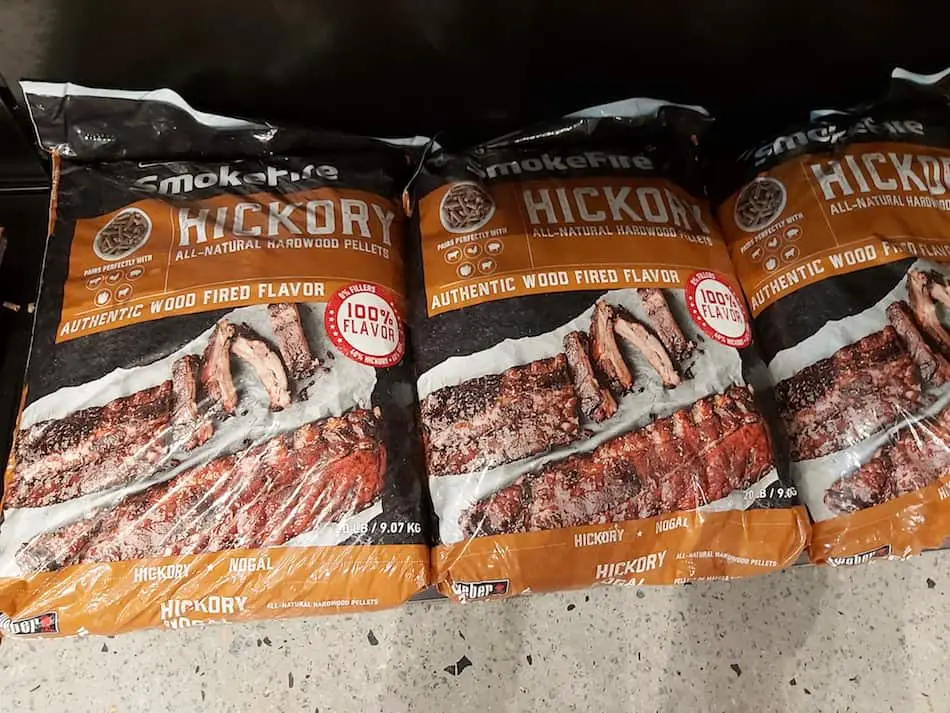
Shredded Brisket and Shredded Pork
Brisket and pulled pork are commonly shredded before serving. Shredding the meat breaks down the tough fibers and connective tissue, making it more tender and easier to eat.
Shredded brisket is typically served as a main dish, often in sandwiches, tacos, or as a topping for salads or pizzas. The meat is often cooked low and slow, which makes it very tender and easy to shred. To shred brisket, it is usually cooled slightly, then pulled apart with two forks or by hand.
Pulled pork is also commonly shredded before serving, it is a staple of barbecue culture. The pork shoulder is cooked low and slow until it becomes extremely tender, and then it is pulled apart into thin strands. This process is often called “pulling” the pork.
Pulled pork is commonly used in sandwiches, tacos, or as a topping for salads, pizzas, and even mac and cheese. It can also be used as a filling for quesadillas and burritos.

What To Serve With Brisket And Pulled Pork
You can serve pulled pork and brisket with a variety of sides and condiments, which enhance their flavors and make for a delicious and satisfying meal. A traditional American coleslaw is a great option for both pulled pork and brisket.
The cool, creamy slaw complements the smoky, rich flavor of the meats and adds a refreshing contrast of texture. A popular way to serve pulled pork is in sliders or sandwiches, where the coleslaw adds a nice crunch and tanginess. Smoked brisket also goes well with coleslaw, whether it’s served on a sandwich, or as a side dish.
Another side dish that pairs well with both pulled pork and brisket is smoked mac and cheese. The creamy, cheesy pasta provides a comforting contrast to the smoky, savory meats and makes for a hearty and satisfying meal.
Other side dishes that complement pulled pork and brisket include roasted or grilled vegetables, such as corn, bell peppers, and onions, which add a burst of freshness and color to the plate. Baked beans, potato salad, and macaroni salad are also great options.
You can also serve pulled pork and brisket with different sauces, such as barbecue sauce, mustard sauce, or hot sauce, depending on your preference.
How To Smoke a Brisket
- Set the temperature of your smoker to between 225° F and 250° F.
- Trim your brisket, leaving 1/4 of an inch of fat on the top and remove all the silver skin on the bottom.
- Slather your brisket of olive oil to help the rub and seasoning stick.
- Use your favorite barbecue rub and cover the brisket with the seasoning. You can use a pre-made rub, or use a homemade recipe. If you want a smoked brisket like Aaron Franklin, just use a simple coarse kosher salt and coarse black pepper on your brisket.
- Place the brisket in your smoker with some hickory, oak, all your favorite smoking wood.
- Leave the brisket alone for about 5 hours and let it develop a nice crispy bark.
- Once the bark is developed and the internal temperature has reached around about 160 or 170° F, wrap the biscuit in foil or butcher paper.
- Continue cooking the brisket until the internal meat temperature reaches around about 200° F.
- Check the brisket for tenderness by poking it with a toothpick or a bamboo skewer. Once it feels like you’re poking a stick of butter, then you have reached the ideal done temperature.
- Rest of the brisket for about 1 hour, or place into holding by putting it in a dry cooler for up to 4 hours.
How To Smoke Pulled Pork
- Trim the pulled pork, leaving fat on the top but remove rind.
- Try to buy a piece of pork shoulder that has the bone intact. It will help keep the meat moist and is good for tenderness testing.
- Cover the pork shoulder with your favorite barbecue rub.
- Set the temperature of your smoker to 275° F.
- Use your favorite smoking wood. Hickory works best with pork.
- Leave on your smoker for about 4 or 5 hours until the bark has hardened.
- Wrap the pork in foil or butcher paper and continue smoking until the internal temperature reaches around about 200° F.
- Let the pork shoulder rest before shredding. Allow at least 1 hour resting time.
- Once the pork has rested for 1 hour, shred and serve.
Smoked Brisket

Tender, juicy smoked brisket cooked low and slow on a smoker.
Ingredients
- Brisket
- Barbecue rub
- Kosher salt ( for the dry brine)
- Yellow mustard or olive oil ( for the binder)
Instructions
1. Select a brisket with good marbling.
2. Trim the fat but leave 1/4 inch of fat on top.
3. Dry brine the brisket by sprinkling kosher salt on both sides of the meat and refrigerate for a few hours or overnight.
4. Inject the brisket with broth or marinade. * Optional
5. Slather the brisket with olive oil or yellow mustard. *Optional
6. Apply an even layer barbeque rub. If the rub contains salt, skip the dry brine step.
7. Use hickory, oak, pecan or your favorite smoking wood.
8. Set the temperature of your smoker between 225°F to 250°F
9. Place the brisket in smoker away from the heat source.
10. Fill the water pan with hot water.
11. Insert a leave-in meat thermometer into the brisket.
12. Leave the brisket alone for the first 3 hours or so. Allow the brisket to absorb smoke and develop a bark.
13. Once the rub has fused to the meat, begin to spritz the brisket every hour with either apple juice, broth, apple cider vinegar or beer. Otherwise, mop with a mop sauce.
14. Once the bark is firm, wrap the brisket in foil or butcher paper. By this stage, the meat should have reached an internal temperature between 150°F and 160°F.
15. Insert the thermometer into the meat and place the brisket back in the smoker.
16. Continue cooking until the brisket is tender as butter when poked with a toothpick or probe. The internal meat temperature should read somewhere between 195°F and 203°F when perfectly tender.
17. Allow the meat to rest for about 1 hour before slicing. If you're not ready to serve, place the brisket into a dry cooler. Keep the brisket wrapped in foil or butcher paper, then wrap again with a towel or dish cloth. The brisket will remain hot for over 4 hours. Keep a thermometer probe inserted.
18. Slice against the grain and serve.
Nutrition Information:
Serving Size:
85 gramsAmount Per Serving: Calories: 246 grams
My Favorite Brisket Tools
Thanks for checking out this article. I hope you learned a few things. Here are some of my favorite tools I use when smoking brisket that may be useful to you. These are affiliate links, so if you decide to purchase any of these products, I’ll earn a commission. But in all honesty, these are the tools I recommend to my family and friends who are just starting out.
Meat Injector: Injecting meat is a great way to take your barbecue to the next level and help you make competition-style brisket. An injector is the only way you will be able to get flavor and moisture into the middle of the meat. The Beast Injector is a stainless steel injector that is sturdy and affordable. Check the latest price on Amazon here.
Brisket Marinade: The best injection solution on the market is the Butcher BBQ Brisket Injection. This marinade is used in competitions and is made by World Barbecue Champion pitmaster, Dave Bouska. You can find the marinade on Amazon here.
Butcher Paper: Wrapping brisket in butcher paper has become a huge trend in barbeque thanks to Aaron Franklin. Wrapping your brisket in paper will give you a nice brisket bark. However, you can’t just use any old paper, it has to be unwaxed, food grade paper. You can find it on Amazon here.
Brisket Rub: These days I make my own rub when possible, but I always have a few pre-made rubs for when I’m running low. Barbecue guru Malcom Reed produces Killer Hogs, one of the best brisket rubs I’ve found over the years. Another great rub is Slap Yo Daddy, made by brisket master and multiple World Barbecue Champion, Harry Soo.
Meat Thermometer: There are dozens of fancy thermometers on the market, but I still use my trusty TP20. For around $50, I have a high-quality meat thermometer with two probes, and can track the temperature of my smoker with one probe, and my meat with the other probe. The ThermoPro TP20 is an Amazon Best Seller because it’s the easiest thermometer to operate, is durable, highly accurate, and comes with pre-programmed meat settings.
Instant Read Thermometer: Arguably, the second most important tool you need is a fast and accurate instant-read thermometer. These tools play an important role in the latter stages of the cook when the meat needs regular checking in multiple areas. I use the ThermoPro TP19 because it can do everything a ThermaPen can do, but for a fraction of the cost. You can check out the TP19 on Amazon here.
Advanced Thermometer and Automatic Temperature Controller: Once you’re ready to take things seriously, the FireBoard 2 Drive is a six-channel Bluetooth/Wi-Fi thermometer that can monitor up to 6 pieces of meat, control and graph your cook sessions on your smartphone, and attaches to an an automatic blower that will convert your charcoal smoker to a set-and-forget. This is one of the most advanced meat thermometers on the market. You can check it out on the FireBoard website here.

